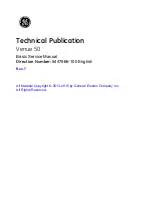
Operator's Manual
WP700Zi-OM-E-RevA
144
How the Instrument Enhances Resolution
The instrument's enhanced resolution feature improves vertical resolution by a fixed amount for each filter. This
real increase in resolution occurs whether or not the signal is noisy, or your signal is single-shot or repetitive. The
signal-to-noise ratio (SNR) improvement you gain is dependent on the form of the noise in the original signal. The
enhanced resolution filtering decreases the bandwidth of the signal, filtering out some of the noise.
The instrument's constant phase finite impulse response (FIR) filters provide fast computation, excellent step
response in 0.5 bit steps, and minimum bandwidth reduction for resolution improvements of between 0.5 and 3
bits. Each step corresponds to a bandwidth reduction factor of two, allowing easy control of the bandwidth
resolution trade-off. The parameters of the six filters are given in the following table.
Resolution increased by
-3 dB Bandwidth
(x Nyquist)
Filter Length
(Samples)
0.5 0.5 2
1.0 0.241 5
1.5 0.121
10
2.0 0.058
24
2.5 0.029
51
3.0 0.016
117
With low-pass filters, the actual SNR increase obtained in any particular situation depends on the power spectral
density of the noise on the signal.
The improvement in SNR corresponds to the improvement in resolution if the noise in the signal is white -- evenly
distributed across the frequency spectrum.
If the noise power is biased towards high frequencies, the SNR improvement will be better than the resolution
improvement.
The opposite may be true if the noise is mostly at lower frequencies. SNR improvement due to the removal of
coherent noise signals - feed-through of clock signals, for example - is determined by the fall of the dominant
frequency components of the signal in the passband. This is easily ascertained using spectral analysis. The filters
have a precisely constant zero-phase response. This has two benefits. First, the filters do not distort the relative
position of different events in the waveform, even if the events' frequency content is different. Second, because
the waveforms are stored, the delay normally associated with filtering (between the input and output waveforms)
can be exactly compensated during the computation of the filtered waveform.
The filters have been given exact unity gain at low frequency. Enhanced resolution should therefore not cause
overflow if the source data is not overflowed. If part of the source trace were to overflow, filtering would be
allowed, but the results in the vicinity of the overflowed data -- the filter impulse response length - would be
incorrect. This is because in some circumstances an overflow may be a spike of only one or two samples, and the
energy in this spike may not be enough to significantly affect the results. It would then be undesirable to disallow
the whole trace.
The following examples illustrate how you might use the instrument's enhanced resolution function.
In low-pass filtering:
The spectrum of a square signal before (left top) and
after (left bottom) enhanced resolution processing. The result clearly
illustrates how the filter rejects high-frequency components from the signal.
The higher the bit enhancement, the lower the resulting bandwidth.
Summary of Contents for DDA 7 Zi series
Page 1: ...Operator s Manual WavePro SDA and DDA 7 Zi Series Oscilloscopes ...
Page 2: ... L R R H HUD RU D D ...
Page 41: ...Operator s Manual WP700Zi OM E RevA 40 The detachable WavePro Zi front panel ...
Page 376: ...WavePro 7Zi 375 WP700Zi OM E RevA Absolute Offset Relative ...
Page 439: ...Operator s Manual WP700Zi OM E RevA 438 ...
Page 440: ...WavePro 7Zi 439 WP700Zi OM E RevA ...
Page 544: ...Thank you for purchasing a WavePro SDA or DDA 7 Zi Oscilloscope ...
















































